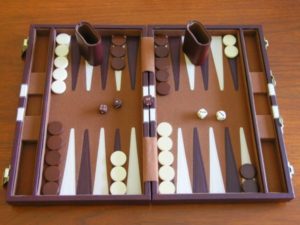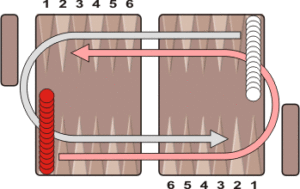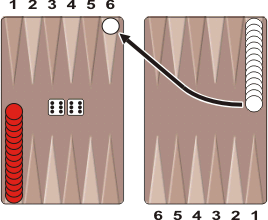Fevga – Backgammon Variant

Setup: Each player starts with fifteen checkers on the rightmost point of the far side of the board, at diagonally opposite corners from each other. They both move in the same direction, counterclockwise, around the board.
Object: The object of the game is to move all your checkers around the board and bear them off. White bears off at the lower-right; Red bears off at the upper-left.
To start: Both players roll one die and the higher number goes first. That player rolls the dice again to begin his turn. After the first game, the winner of the previous game goes first.
Movement: The roll of the dice indicates how many points, or pips, the player is to move his checkers. The following rules apply:
- A checker may be moved only to an open point, one that is not occupied by any opposing checkers.
- The numbers on the two dice constitute separate moves. For example, if you roll 5 and 3, you may move one checker five spaces to an open point and another checker three spaces to an open point, or you may move the one checker a total of eight spaces to an open point, but only if the intermediate point (either three or five spaces from the starting point) is also open.
- Doubles are played twice. For example, a roll of 6-6 means you have four sixes to use.
- You must use both numbers of a roll if possible, or all four numbers in the case of doubles. If you can play one number but not both, you must play the higher one.

First checker away: Your first checker must pass the opponent’s starting point before you may move any of your other checkers.
No hitting: A major difference between Fevga and other forms of backgammon is that there is no hitting in this game. One checker by itself controls a point, and an opposing checker may not land or touch down there.

Limitation on primes: You are not allowed to block all six points in your starting table.
If you have built a prime (six consecutive blocked points), and your opponent has collected all his checkers onto the one point behind your prime, then you must unblock a point in your prime to allow him a chance to move.
Bearing off: Once you have moved all fifteen of your checkers into their finishing table, you may begin bearing off. You bear off a checker by rolling a number that corresponds to the point on which it resides, then removing the checker from the board.
If there is no checker on the point indicated by the roll, you must make a legal move using a checker on a higher-numbered point. If there are no checkers on higher-numbered points, you must remove a checker from the highest point that has a checker.
Scoring: The first player to bear off all his checkers wins the game and scores one point. If the winner bears off all his checkers before the loser has borne off any, he gets two points.